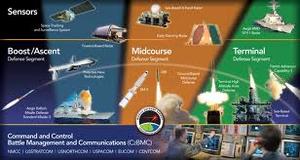Ballistic missile defenseComparing boost-phase to non-boost-phase ballistic missile defense
An expert panel set forth to provide an assessment of the feasibility, practicality, and affordability of U.S. boost-phase missile defense compared with that of the U.S. non-boost missile defense when countering short-, medium-, and intermediate-range ballistic missile threats

Layered ballistic missile defense system // Source: mda.mil
An expert panel with a long name — the Committee on an Assessment of Concepts and Systems for U.S. Boost-Phase Missile Defense in Comparison to Other Alternatives — set forth to provide an assessment of the feasibility, practicality, and affordability of U.S. boost-phase missile defense compared with that of the U.S. non-boost missile defense when countering short-, medium-, and intermediate-range ballistic missile threats from rogue states to deployed forces of the United States and its allies, and defending the territory of the United States against limited ballistic missile attack.
A National Research Council release reports that to provide a context for this analysis of present and proposed U.S. boost-phase and non-boost missile defense concepts and systems, the committee considered the following to be the missions for ballistic missile defense (BMD):
- protecting the U.S. homeland against nuclear weapons and other weapons of mass destruction (WMD), or conventional ballistic missile attacks
- protection of U.S. forces, including military bases, logistics, command and control facilities, and deployed forces, including military bases, logistics, and command and control facilities
They also considered deployed forces themselves in theaters of operation against ballistic missile attacks armed with WMD or conventional munitions, and protection of U.S. allies, partners, and host nations against ballistic-missile-delivered WMD and conventional weapons.
Consistent with U.S. policy and the congressional tasking, the committee conducted its analysis on the basis that it is not a mission of U.S. BMD systems to defend against large-scale deliberate nuclear attacks by Russia or China.
Making Sense of Ballistic Missile Defense: An Assessment of Concepts and Systems for U.S. Boost-Phase Missile Defense in Comparison to Other Alternatives suggests that great care should be taken by the United States in ensuring that negotiations on space agreements not adversely impact missile defense effectiveness. This report also explains in further detail the findings of the committee, makes recommendations, and sets guidelines for the future of ballistic missile defense research.
